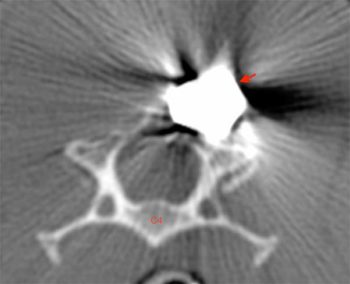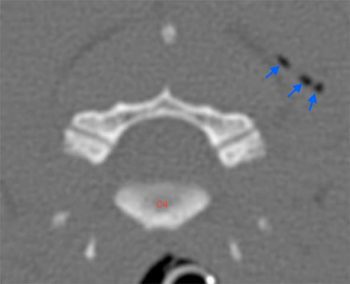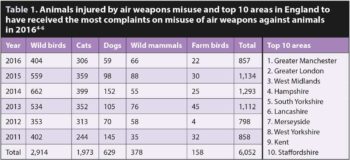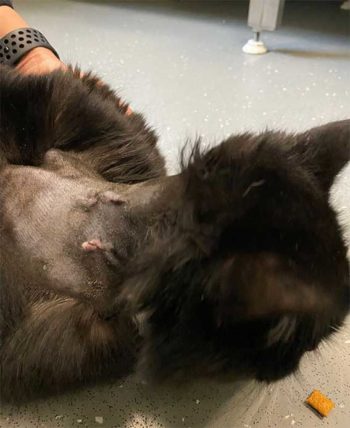19 Apr 2022
Anna Tauro DVM, GPCert(Neuro), DipECVN, MRCVS and Adelina Proteasa DVM, PhD, PGCert(SAS), MRCVS recount the case of a feline patient and discuss the law against such weapons.

Figure 1. Lucy before discharge.
Although since 2006-7 the number of recorded air weapons offences dropped by 81% in Scotland and 67% in England and Wales1, the press is still flooded with headlines involving airgun attacks on animals – and there is nothing more real than when those headlines have a face.
Lucy, a two-year-old domestic long-haired cat (Figure 1), was presented to her first opinion veterinary practice after she was missing for three days. Lucy was presented with non-ambulatory tetraparesis, more pronounced on her right-hand side. She also had a 1cm wound on the right-hand side of her neck, which was partially closed by a scab.

Routine blood work (namely haematology, serum biochemistry profile and electrolytes) showed a mild elevation of alanine transaminase. Radiographs showed a metal object, likely a bullet, on the right side of the cervical vertebra C4, near its dorsal lamina. Meloxicam was administrated and Lucy was referred to ChesterGates Veterinary Specialists.MRI could not be performed, as the composition of the embedded bullet could not be identified: a ferromagnetic bullet is a high-powered magnet and, therefore, the powerful magnetic field of the MR system can heat or move them, making MR study unsafe for the patient.
CT was performed and showed a metal artifact typically displayed as bright and dark streaks at the level of the right dorsal lamina of the C4. This was associated with a small defect within a right lateral cutaneous and SC tissues, and several small gas attenuating foci throughout the soft tissues at this level. These findings supported a penetrating neck injury (Figure 2).
The metal artifact prevented the assessment of any injuries affecting the cervical vertebrae, so Lucy underwent a surgical intervention to remove the bullet.
The cervical spine was approached dorsally, and dissection was carried down in the midline through the SC tissue and the fascia to the tip of the spinous process and right dorsal lamina of the C4 vertebra.
The presence of the metal bullet was confirmed; this was removed, together with debris and hair. Copious flushing with saline was performed before closure. The right-hand side skin wound was inspected, debrided and flushed with saline before closure (Figure 3).

CT was then repeated and revealed a depressed fracture of the caudal aspect of C4, which was minimally displaced ventrally and impinging on to the dorsal epidural fat, but without causing compression of the spinal cord. Spinal cord contusion resulting from gunshot injury was suspected. MRI study was considered, but not performed due to financial constraints (Figure 4).
Pain management alongside broad-spectrum antibiotics such as potentiated amoxicillin was continued.
Lucy underwent a rehabilitation programme and remarkably improved over the following four days, returning to be ambulatory with minimal proprioceptive ataxia and paresis.
An air weapon is a gun that fires projectiles pneumatically with compressed air or other gases (most commonly carbon dioxide) which are mechanically pressurised without involving any chemical reactions, in contrast to a firearm. Air weapons come in both long gun (air rifle) and handgun (air pistol) forms.
Air weapons are used for small game hunting, pest control, recreational shooting (commonly known as plinking) and competitive sports.
Scotland and Northern Ireland have licensing laws for air weapons, but in England and Wales you do not need a licence to own most air weapons.

The system of licensing air weapons was introduced in January 2017, and by mid-2017 the BBC reported that around 15,000 people had applied for licences and around 21,000 weapons had been surrendered to the police2.
In England and Wales, air weapons with power levels of between 1ft/lb and 12ft/lb (for air rifles) or 1ft/lb and 6ft/lb (for air pistols) are considered low-powered air weapons and do not fall within the present licensing regime, although the Firearms Acts contain a package of statutory controls intended to prevent their misuse3.
Furthermore, air weapons have restrictions on their sale and the minimum age for the possession of an air weapon is 18 years. However, the law allows people under the age of 18 to possess an air weapon:

The British Association for Shooting and Conservation (BASC) works to protect the lawful right to use air guns and offers guidelines for people using them.
Despite the above, the RSPCA reported 6,052 cases of air guns attack on animals between 2011-16 (Table 1). Yearly, the RSPCA receives more than 1,000 complaints from the public regarding misuse of air guns against animals.
Due to lack of accurate and reliable information or proof of intent, less than five cases a year are prosecuted.
Although the rise of air guns attacks on animals reported by the RSPCA, Cats Protection and veterinary professionals communicate a clear public concern, the Government is not planning to introduce a licensing system for air weapons in England and Wales7.
The main reasons against air weapon licensing seem to be the additional administration burden and cost for police forces or air weapon users, as well as the barriers that further restrictions would create to people involved in sport shooting. In the wrong hands, an air weapon can cause serious injury or even kill8.
The leading feline welfare charity Cats Protection, in association with veterinary professionals, has conducted a survey on air gun attacks on cats and concluded that “many more cats are killed in air gun attacks than 20 years ago”9. Cats do not know “boundaries”: allowing people under the age of 18 to possess an air weapon and to fire within the boundary of their premises can be lethal to animals.
The RSPCA and Cats Protection have been long calling for a licensing system in England and Wales to help prevent animal attacks. A Cats Protection petition to license air weapons in England and Wales is still open, and can be signed at www.cats.org.uk/airgunpetition
The RSPCA encourages all members of the public and professionals to telephone the hotline 0300 1234 999 and report all cases suspected of misuse of an air weapon against any animals.